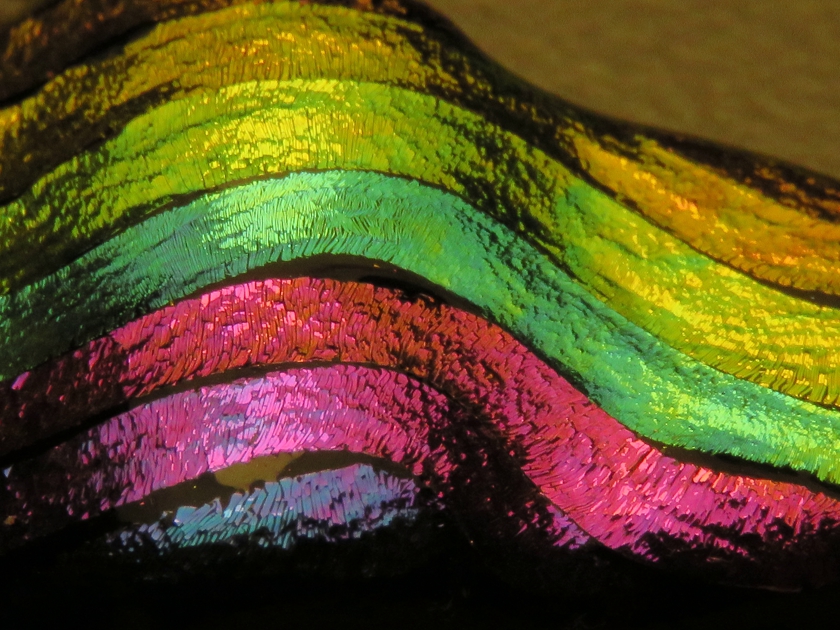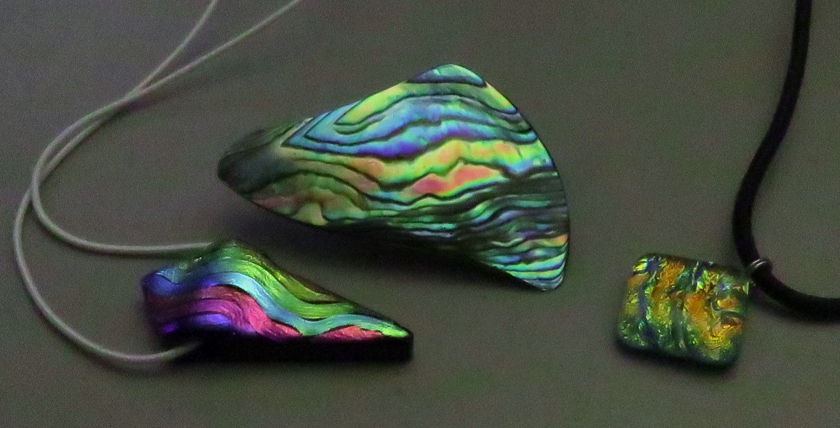Extreme closeup photos can be beautiful and/or informative. They can also be riddles. Three macro photos are posted here. What on earth do they depict? The mystery of why we call extreme closeups “macros” will have to wait.



Macro ~ Pic and a Word Challenge #338
The image in the challenge is enigmatic, and so (I hope) are the images above. Scroll down to see the answers to the riddles they pose.
↓
↓

– Gray button (upper left corner) reveals widgets, –
– above post (on phone) or beside it (on desktop). –
– above post (on phone) or beside it (on desktop). –
Very cool!
I figured the second one was the inside of a shell, so pearlescent. But the others had me stumped maybe stained glass?
Now looking at the jewelery, are the last two opals?
Great subjects for macro photography!
LikeLiked by 2 people
Thanks. Glad U were not turned off by the quirkiness of how I do macros. No dedicated lens, but the camera has a “macro” setting that imitates one, with varying degrees of partial success (and sometimes an interesting failure). Can’t get the gr8 sharpness of your challenge image when that close.
Yes, object #2 is a pin that I am pretty sure was made from a shell fragment. (Dunno how the jeweler got convex curvature on what seems to be the inside.) Dunno exactly what is in objects #1 and #3. Both have bits of shiny stuff (foil?) embedded in glass or very hard plastic. No opals. The last image shows the objects lined up in the order of the first 3 images.
LikeLiked by 2 people
<smile> Bold colours and lines in spectacular designs… What’s not to love!? 🙂
Macro’s finicky even with a proper macro lens: first there’s that micro depth of field, and then too, the slightest shake is as magnified as the subject. That miniscule depth of field makes focus … interesting — it defies auto-focus. Definitely an exercise in frustration without a tripod!
I shot the challenge photo, and the one I posted yesterday, with a telephoto zoom lens and a couple of macro extension tubes. If you’re not familiar, these increase a lens’ magnification by increasing the distance between the lens and the image sensor. A poor man’s macro solution. The tubes increased the maximum magnification of the 55-200mm lens from a paltry 18% to a more respectably macro-ish 65%.
Of course, the depth of field isn’t any better than a true macro lens. But there’s a way to widen the depth of field called “focus stacking”. First, bracket a bunch of photographs of your subject, changing the focus point from near to far one step at a time for each photo. Then, use software (such as Photoshop) to merge the in-focus parts of every capture into a single image with a wider depth of field. It’s pretty labour intensive and the merge will tax your computer’s processor and memory. But, the result can be well worth all that effort.
Fortunately, there’s a feature on my Fuji cameras that automates the focus bracket over the depth of field I want. For example the snowman ornament photoposted on my blog yesterday took 31 captures to create. Without the focus stack, the only thing that would have been in focus would have been his eye dots but not his nose, scarf, or that lovely little yellow kick off the left side of his noggin.
LikeLiked by 1 person
Thanks again. Focus stacking was new to me, and I will look for focus bracketing if I decide to spring for a more capable camera. My camera’s autofocus often gets confused, and the manual override is a lame joke.
LikeLiked by 1 person
When you look for that more capable camera, seek one which provides manual focus assistance via focus peaking. Best way too know exactly what’s in focus (and what’s not 😉 ) when focusing manually.
LikeLiked by 1 person
Will do. 🙂
LikeLiked by 1 person
Love those macros. Very creative. 😁
LikeLiked by 2 people
Thanks. 🙂
LikeLiked by 2 people
I wonder if the shell might be what’s beneath the crusty outer side of an abalone. The other two look almost fuzzy with those little filaments. Not quite like butterfly wings, but surprisingly unlike the hard charms they turned out to be. Excellent answer to the macro challenge.
LikeLiked by 1 person
Thanks. Bet U are right about grinding away the outer shell, no doubt after applying a thick layer of adhesive to the inner surface and letting it set. The other side of the pin is uniformly dark and could well be hardened gunk that supports what’s left of the original shell. That’s more likely than somehow making the shell temporarily bendable.
The shiny little flecks in #1 do look remarkably like the tiny scales seen in macros of butterfly wings. To me, #3 looks rather like the colorful pools formed by hot springs in places like Yellowstone NP.
LikeLiked by 1 person
Fascinating.
LikeLiked by 2 people